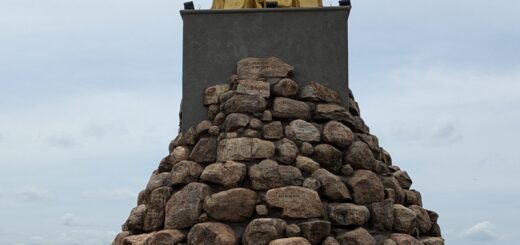Agra, India #54

February 15
Today we did not have to set an alarm – Yeah!! But, people were loud all through the night – Boo! So we did not sleep well. Anyway, we got around by 0700. The mornings are cool and this makes our room pretty cool as well. We don't have a heater, but we have AC – Hahaha 🙂 The manager gave us the hot kettle (we are supposed to have) and I made my own coffee!! It is my try of the Ground Zero coffee and it was soo good! Jeff had some hot chocolate. I also was able to talk with my sister and able to show her the Taj Mahal view from our rooftop. (It was not the greatest this morning, due to very foggy conditions.)
At 0850 we went to the closest restaurant, The Green View. I ordered Indian Muesli and a black coffee; Jeff had a Indian (Masala) Omelette and a chai. At 0915 we got our drinks. 0920 Jeff got his omelette, and our driver showed up. Finally at 0930 I received my order, which was chopped banana and apple with curd and a spoon of red jamon top (no Muesli in sight). I finished quickly because I was hungry and it was good. I went back to the hostel to use the bathroom (the restaurant did not have one). We loaded up into our driver's car. We booked him for a “full” day. Jeff had an agenda of three places yet to see in the Agra area, but they require driving due to distances.
Our first place is the last World Heritage Site in the Agra area. It is Fatehpur Sikri, and it is a 44 km (27 miles), taking us around one hour to get there. We stopped because our car needed gas and he hit Jeff up for an advance of 1000 Rupees ($12.50). On our way, another car crunched into us just enough to hear it, but thankfully, we were only going about 5 mph! Neither driver seemed concerned as they did not even stop to get out and evaluate. Our driver did ask if we were alright. The other car went on his way and we went on ours. Really, okay?!? Questions??? Anyway, we arrived without anymore “fender benders” around 1100.
Sikri is actually the name of a city that this site was built on. The Mughal Emperor, Akbar, moved here (1572-1585) due to a Hindu religious leader (a Sheikh), Shaikh Salim Chishti, being here. The Sheikh is said to have blessed Akbar, who had no heir, and the emperor with his favorite wife had a son. So Sikri was renamed Fatehpur Sikri – the 'City of Victory', due to a military victory. A religious compound was built to commemorate the Sheikh who predicted the birth of the heir, and a walled city and imperial palace was also built – it became the capitol.
You enter through a gate of the original walled fort city (ticket entry).This place was fun to walk around and see different buildings all with the red sandstone, predominantly. There are Hindu and Muslim influences. The first focal point inside is the Panch Mahal, which is a five-storied structure. Each story is smaller with the top being one room size capped with a dome. We could not go up the upper four levels, and probably this is for the best. It is very dainty looking and believed to be for the ladies of the court. There was another building named the Jewel House, but it's purpose is not known. It had a very unique interior support system There was a central column that only went up one story of the two story building. But there were four massive supports from each corner to this central column. It was impressive. Next was the Treasury. This building had a big open room flanked by two smaller symmetrical rooms. This ceiling was supported with carved brackets. One more building of note, the Shabistan-I-Iqbal. It is a palace of Akbar's, and still had some azure-blue glazed tiles on the roof. Wow! There were so many beautiful buildings here, I could go on and on. A beautiful garden (along one side) of a brilliant green lawn contrasted nicely with the whole complex. The last thing was a water holding area more or less in the center, and it still holds water. We exited the planned city of Fatehpur Sikri.
We walked a fair distance to the religious compound, Jama Masjid. It is free!! We enter through the stunning southern gate, Buland Darwaza, climbing the steep stairs up into the complex. Entering in a walled, squared, symmetrical area. Immediately there is a contrast to the symmetry with a white marble building just off center. It is the tomb of Salim Chisti, who foretold the Emperor Akbar's son and heir. It is very intricately carved tomb, but more with geometric shapes. There are also other tombs here just in the square for the ancestors of the the Hindu religious leader. There is also a mosque, that was the largest mosque of the empire at that time. It was also an impressive complex with the grandest entry I've come up into in quite awhile, maybe since Petra(?).
Now, we went back to our taxi and moved on. As we were going to our second site of the tour, Jeff and I both realized we need to be more aware of World Heritage Sites. Also as we were going to our next place we saw a procession of a shrouded body being carried by four men for cremation. That was interesting in the fact that they were just walking in a lane of traffic! The Indian culture definitely treats death way differently. I mean, here we were watching this body being carried in reverence and we are seeing all these tombs/mausoleums all for respect to their dead. It is just something to think on. That all being said, we arrived Akbar Tomb Sikandra.
This mausoleum is a large complex also. It has a four gated entry with his tomb being in the middle. There are large pathways leading from each gate to the tomb, and in the middle of the pathways are troughs for water (no water is present right now). It is very elaborate. Once inside the mausoleum the tomb itself is very simple, made of white marble. On site there is also the Kanch Mahal, a palace that was a harem quarter; the Lodhi Tomb, a tomb that is in a state of ruin and unknown who is buried here. Finished we loaded up and go to our last site for today.
We arrive at I'timad-ud-Daulah, it is known as the little Taj Mahal, and is the grandfather of Mumtaz-Mahal of the Taj Mahal. Anyway, it is very similar to the Taj – being made of the same white marble, all carved, with contrasting red sandstone buildings around it, and pathways with water throughs and pools. There are still preserved painted walls and ceilings. The tombs themselves are of white marble and again simple. We walked around the complex and loaded back up in our taxi.
We head back toward our hostel and had our driver end by dropping us off at KFC!! We were starving it was five pm, and we last ate at 9:30 this morning. We had a Zingy Chicken Sandwich, Peri-peri Chicken Pieces, French Fries and a 7UP. It was just what we needed. We had a great, albeit, long day with 14,700 steps. We decided after we ate to walk back to our hostel, one mile. We went up to the rooftop, enjoyed sunset and last distant views of the Taj Mahal. Tomorrow we move on!






